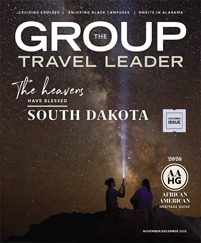“My people would never do that.“
I’ve lost count of the times I’ve heard that phrase over the past 15 years. Whether it’s trying an adventurous activity, staying at an upscale hotel or splurging on a gourmet meal, there are some travel experiences that many tour planners reject out of hand.
Understanding your audience is important. But I’ll go out on a limb with this statement: If you continually fall back on “my people would never do that“ when planning your trips, it might say more about you than it does about them.
Savvy business owners know their customers, and smart group travel planners target trips to the tastes of their potential travelers. But people who succeed over the long term understand that tastes change and demographics shift. What was popular yesterday won’t necessarily be popular tomorrow. And if you don’t give your customers new and exciting things to look forward to, eventually they won’t be your customers anymore.
When I began my tourism career in the early 2000s, the industry was still entrenched in the “senior citizen” mindset. The patterns and practices established by the World War II generation dominated conventional wisdom. When I visited destinations with group sales people, they spent a lot of time talking about accessibility ramps and the number of steps between one place and another.
A funny thing happened on the way to 2020, though: The generation that created most of those expectations stopped traveling. And the generation that took their place brought a different set of travel preferences.
A lot has been written about the impact of baby boomers on the tourism industry. Many people worried initially that boomers wouldn’t travel in groups. Now, thankfully, we have enough evidence to know that’s not true. Groups sizes are smaller, but many boomers still find value and benefit in traveling together.
Lately, though, I’ve noticed a schism opening up in the travel industry. Much of the growth destination development is coming in the form of adventurous activities, upscale hotels and memorable culinary experiences. But when destination marketers try to showcase these developments to the group travel industry, all too often the answer from travel planners amounts to some version of “my people would never do that.”
My response: Are you sure?
I ask this because I have met and traveled with a lot of group tour customers that defy that reasoning. I’ve gone snowmobiling with a group in Montana’s Yellowstone backcountry. I’ve relaxed with group travelers at many exceptional hotels. And I’ve watched, at a group dinner, as customers ordered $100 bottles of wine without batting an eye.
The rules that governed this industry 15 years ago haven’t aged well. Today’s consumers don’t need you to plan simple travel logistics for them — they can do that on their own. But they crave amazing travel experiences, and if you can deliver them, they’ll become loyal customers.
If you limit your scope based on outdated perceptions of what group travelers will and won’t do, you could be holding them back from the experiences they’ll enjoy the most. In the long run, that doesn’t serve them well, and it doesn’t serve you well either.
“My people would never do that.” Maybe it’s time for a change in perspective.










